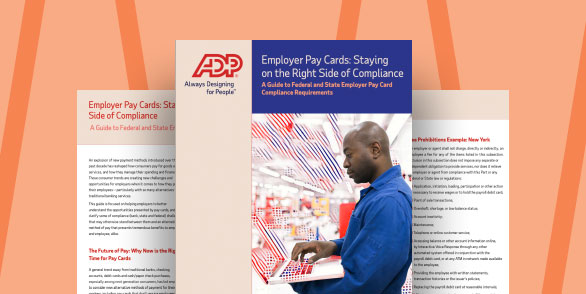insight
Business continuity plan
Natural disasters may raise many business continuity concerns, among them, the safety and financial security of employees. Should employees come into work, or should they work from home? Will they be paid if the business closes early or can’t open? In these uncertain situations, a business continuity plan provides strategic guidance and outlines the tasks necessary to sustain operations. If the plan includes alternative payroll options, it may also help employers meet their legal obligation to pay employees on time.
Table of Contents
What is a business continuity plan (BCP)?
A business continuity plan outlines how an organization will maintain critical operations when a natural disaster or service disruption affects its employees, processes, technology or facilities. It typically includes a list of essential business requirements (what, who, where and how) and strategies for incident response and recovery.
What is business impact analysis?
Business continuity plans are not complete without impact analyses. During this process, employers identify the potential consequences of a disruption to essential business functions. They also use the information available to them at the time to make decisions about recovery priorities. In most cases, the functions with the greatest financial or operational impact are prioritized.
What does a business continuity plan address?
A business continuity plan may be enacted during severe weather events, regional power outages, public health crises and more. To respond to any one of these disruptions, the plan generally should address facility closures, employee and customer safety, payroll requirements, remote work policies, employee communications and data access, and security.
Workplace closures
It’s not uncommon for employers to voluntarily close their place of business during inclement weather for the safety of their employees and customers. If a state of emergency is issued, closure may be mandated by the government. Either case may directly impact payroll in the following ways:
- Nonexempt employees generally are only entitled to pay for the hours they actually work.
- Exempt employees may not have their pay docked in workweeks where they perform any work.
- Employers must abide by reporting-time laws in jurisdictions where applicable.
Remaining open
If a worksite in an impacted area will remain open, employers must consider the likelihood that employees may have difficult commutes and arrive late. The same payroll rules apply in this situation as in closures. Absent a reporting-time pay law, nonexempt employees are only paid for the hours they work, and exempt employees must be paid for a full day’s work even if they arrive late or leave early.
Remote work
Allowing employees to work from home during severe weather and natural disasters may help safeguard them from hazardous commutes and maintain productivity. In their business continuity plan, employers should define the type of work that may be completed remotely and the conditions under which it will be authorized. They should also determine what will be required of employees working from home, e.g., having the necessary technology, maintaining contact with managers and teams, etc.
Employee communications
Employers should try to give employees advance notice of workplace closures during a crisis. However, power outages may make it incredibly difficult to distribute essential information to the entire workforce. In these situations, an “all-of-the-above” communication strategy usually works best. Options include:
- Employee hotlines
- Manual call lists
- Notices on company websites
- Company-wide email messages
- Emergency notification systems
- Social media posts
Authorized decision makers
When deciding whether to close their business during a natural disaster or severe weather event, employers generally have two options. The first is to follow the lead of public schools and federal or state governments. For example, the business continuity plan might stipulate that the workplace will always close during emergencies if local government buildings also close. This approach provides clarity for the organization and relieves the burden of decision-making from the employer.
The alternative option is to make decisions internally, independent of any government closures. Doing so gives the organization flexibility but also makes it more difficult to ensure that all employees know when the workplace is closed. The business continuity plan should indicate the leaders within the organization who have the authority to make these decisions.
Data backup and security
Natural disasters may disrupt access to data and may cause data security issues. Cloud-based payroll and human capital management (HCM) solutions with redundant data centers may help prevent this problem. Such solutions assist with safeguarding sensitive business data and making it accessible, even if the on-premise information technology (IT) infrastructure is compromised.
How to ensure business continuity plan support
Creating a dedicated business continuity team may help ensure that business response and recovery activities are coordinated effectively. Each member should know their specific role and responsibilities in advance of a crisis and have the contact information of other members. They should also be familiar with all business continuity requirements, including critical equipment and documents and remote work protocols.
Testing the business continuity plan
Business continuity planning is an ongoing process. Members of the business continuity team should receive training curriculum and routinely engage in orientation, table-top and full-scale exercises. During these sessions, team members are presented with a hypothetical disaster and discuss how they would implement the business continuity plan if the situation was real. They can then validate procedures and update the plan if any vulnerabilities are discovered.
Why business continuity planning matters
Recovery after a catastrophic disaster may be an uphill battle. To help overcome it, employers need a business continuity management plan that adequately prepares them for unexpected disruptions. Without one, the chances of a full or cost-effective recovery following a disaster are slim.
Benefits of a business continuity plan
Organizations that have emergency management plans are in a far better position to handle an unexpected event, whether it’s a hurricane or cyber-attack, than those that lack a plan. Additionally, businesses that practice plan implementation are better equipped to act quickly and continue critical functions, including payroll, compared to organizations that never perform table-top exercises.
Prioritizing payroll in business continuity plans
Employees affected by natural disasters likely face serious financial burdens, ranging from the need to buy basic essentials to potentially having to rebuild their homes. Government aid and insurance payouts may be slow to arrive, which makes it all the more crucial to pay employees the money they’ve earned as quickly as possible. Printed paychecks requiring postal delivery are not ideal in these situations. Consequently, it’s advisable for employers to make alternative payments available to employees as part of their business continuity program.
Alternative payment options
Offering direct deposit and encouraging employees to sign up for it is one way to help ensure they are paid as quickly as possible in a disaster scenario. In most cases, payment is available once banks are operational. The wait usually isn’t long because banks have robust requirements to ensure they can operate when disaster strikes.
Another option to help ensure employees have speedy access to their wages during a crisis is to offer paycards. This payment method has all of the capabilities of a traditional bank account, such as early access to direct deposit and bill pay. Employees can also use paycards to purchase goods online or at brick-and-mortar stores.
Reporting-time pay
In addition to ensuring employees are paid on time, employers in certain states and the District of Columbia must be cognizant of reporting-time pay laws whenever there is an emergency closure. While these laws differ and may include exceptions, they generally require nonexempt employees to receive pay for a minimum number of hours if they come to the workplace.

Fast. Secure. Direct deposit done right.
Ensure your people get paid accurately and on time, every time with ADP’s payroll solutions.
Frequently asked questions about business continuity plans
Business continuity plan vs. disaster recovery plan: What's the difference?
A business continuity plan is designed to help ensure that critical business processes can continue during a service disruption. A disaster recovery plan is a subset of business continuity planning specific to restoring critical technology infrastructure after a major disaster.
Why is a business continuity plan (BCP) important?
Business continuity plans are important because they may help organizations keep critical operations running during natural disasters and other crises. Those that don’t have a BCP may suffer significant financial harm, fail to meet legal or compliance obligations, and even go out of business.
What should a business continuity plan (BCP) include?
Business continuity plans typically include essential business requirements, risk assessments and strategic response and recovery initiatives. They may also list key employees on the business continuity team and their assigned roles and responsibilities during a crisis.
Want more exclusive business insights like this delivered to your inbox?Subscribe now
This article is intended to be used as a starting point in analyzing business continuity plans and is not a comprehensive resource of requirements. It offers practical information concerning the subject matter and is provided with the understanding that ADP is not rendering legal or tax advice or other professional services.




